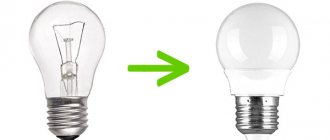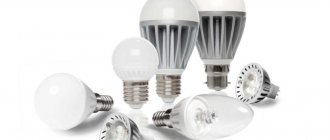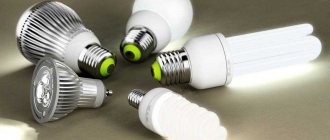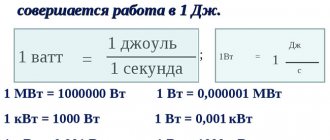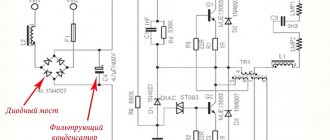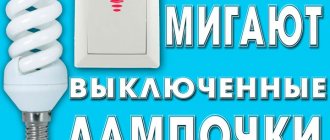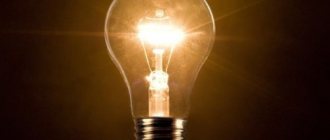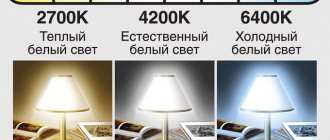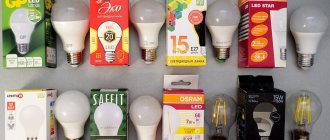Tariffs for electricity consumption are constantly rising. This leads to the fact that most of the population thinks about ways and means of reducing it. Since the main consumption of electricity in domestic conditions is associated with lighting, the selection of high-quality and energy-efficient light sources (light bulbs) is a priority task when developing optimization measures. Until recently, indoor lighting was carried out primarily with incandescent lamps, but recently energy-saving lamps (ESL) have become increasingly popular. The main criteria when choosing a light source are brightness and luminous flux. To compare energy-saving lamps with incandescent lamps, as well as different light sources of the same type, use a special correspondence table.
Types of light sources
Design Features
Until recently, the most common light sources were incandescent light bulbs. They are a sealed flask filled inside with an inert gas. Inside the device there is a tungsten spiral, which begins to glow when an electric current is passed through it. The efficiency of such a product is low, since up to 90% of the energy is converted into heat and spent on heating the surrounding space. In addition, the power of an incandescent lamp is significantly lower than modern analogues, and its service life is much shorter.
To increase light output and color rendering, halogen vapors were added to a sealed flask containing inert gases. Such products are called halogen lamps. This made it possible to reduce energy consumption by 40%, while maintaining the same level of luminous flux.
The next step in development after halogen lamps was fluorescent lamps. Their efficiency level is 70% (that is, 70% of the consumed electrical energy is spent on lighting). They represent the following design:
- Sealed glass tube (this is what standard 36 W lamps look like);
- Inert gas inside it;
- Mercury vapor to improve luminous flux parameters;
- A layer of phosphor that glows when an electric current is applied.
Until recently, standard fluorescent lamps were used primarily in office, retail or industrial premises. Due to their bulky design, their use in residential buildings was difficult. Later, engineers solved this problem by placing the starting device in the base and making the tube in the shape of a spiral. As a result of such improvements, it became possible to install energy-saving lamps instead of conventional products that use the incandescent principle in lighting and, thus, reduce energy consumption.
Important! To maximize the efficiency of LED lamps, it is necessary to determine the optimal voltage for which it is designed. If the voltage is higher or lower, the light output may decrease or the service life will be significantly shortened.
Fluorescent light bulbs
Scope of use
Before the advent of energy-saving lamps, incandescent light bulbs were used in industrial areas, household use, etc. This application was due to the ease of installation and operation. But even now these lamps can be seen often:
- Internal and external lighting of rooms, streets, offices.
- Workplace lighting.
- Automotive incandescent lamps.
- A small bulb of this type is also screwed into the flashlights.
- In public transport, trains, etc.
Characteristics of light sources
Power supply made from energy-saving lamps
To compare their different types, you should use the following parameters:
- Lamp power is the amount of electrical energy consumed within one hour, measured in watts (W);
- Lighting efficiency is the luminous flux generated per unit of electricity consumed (1 W). The power of LED lamps is 5 times higher than that of their conventional counterparts;
- Color rendition - the comparative degree of correspondence between the apparent and natural colors of the illuminated object;
- Luminous flux is the amount of light emitted by its source. Measured in lumens.
Where to buy LED lamps
You can resolve the issue as quickly as possible by visiting the nearest specialized store. The optimal option, in terms of price-quality ratio, remains purchasing from the AliExpress online store. Mandatory long waits for parcels from China are a thing of the past, because now many goods are in intermediate warehouses in destination countries: for example, when ordering, you can select the “Delivery from the Russian Federation” option:
| Modern LED Chandelier for Home | Table lamp Baseus, LED, magnetic | LED kitchen lighting, 5 W, 6 W, 7 W |
| Goodland LED street lamp, solar powered and motion sensor | LED RGB Lampadas, with remote control | LED lamp E14, E27 |
Classification of energy-saving lighting sources
Advantages of using filament lamps
Initially, LED fluorescent lamps were produced primarily for advertising purposes. One was different from the other; there were no uniform standards. As they gained popularity among users, they needed to be grouped by characteristics to make it easier for the buyer to select a product to meet their own needs. The following markings have been introduced:
- The first letter in the name characterizes color rendition: B – the device emits white light, U – belongs to the universal category, D – recommended for use in daylight, C – has improved color rendition;
- In the labeling of foreign-made products, the number comes first. It means the color code (to use the product at home, the parameter value should be 8). Next, the color temperature is indicated (for household devices its value should be 27, 30 or 36);
- The size of the base is also indicated on the product. It can be E40 (for large energy-saving lamps), E27 (standard version) and E14 (for small-diameter sockets);
- You can compare LED lamps by power. It is indicated in the labeling in the number of watts and is designated W. The most common products are those with a volume of energy consumption from 11 to 18 W;
- The possibility of smooth inclusion is indicated in the marking with the letters RS;
- The recommended voltage for effective operation is indicated in volts and is usually 12 V (car lamps), 126 V (American standard) and 220 V (European standard).
Types of light bulbs
Additional Information. A real breakthrough in lighting has been the use of LED lamps. This type allows you to significantly reduce energy consumption, while simultaneously improving light output and fire safety. Their service life also increases. The luminous flux of LED lamps depends on the number of lighting elements connected in a special matrix (the more there are, the better the illumination of the space).
Mercury arc light sources should be mentioned. They are very popular due to their long service life, high efficiency and reliability during operation. The luminous flux of DRL lamps is one of the largest among analogues, and color rendition is close to optimal. Lighting is carried out with white light, which is considered more natural for humans.
Table of light parameters
One of the parameters characterizing a light bulb is color temperature. To measure it, there is a special Kelvin temperature scale. First of all, the degree of whiteness of the illumination emitted by the lamp is determined.
The main color temperatures include the following:
- Warm white, with an indicator below 3000 K.
- Neutral white (natural light), ranges from 3000-5000 K.
- Daytime white (cold light) is over 5000 K.
In living spaces, it is recommended to use soothing and relaxing warm shades. For office premises, the best option would be light in cool tones. Natural light with a color temperature of 2800-3500 K is perceived best.
An important indicator is the luminous efficiency parameter, measured in lm/W. It determines the productivity of electricity and the amount of light produced by a particular light bulb. The level of illumination of any surface, measured in lux (lx), is of great importance.
The transmission of natural tones of illuminated objects is determined using the color rendering index. For light bulbs, this indicator is related to spectral radiation. Absolutely correct transmission is indicated by the Ra index. A decrease in this indicator indicates a deterioration in color rendering properties.
How to choose a lighting device
Various ways to connect one, two or more lamps
First of all, it is necessary to compare power. This will allow you to select a product with the optimal level of electricity consumption. At the same time, when comparing, it is necessary to remember that a 60-watt light bulb will shine much worse than a 100-watt one.
Note! As a rule, lighting devices with a large amount of electricity consumption (60, 75, 100 W) are incandescent light bulbs, the efficiency of which is significantly lower than LED or fluorescent ones.
An equally important parameter is the luminous flux; it allows you to find out how many lumens are in the lamp. To link these two parameters, there is a special table showing the ratio of the power of an LED lamp to an incandescent or fluorescent lamp.
table of correspondence
Analyzing such an equivalence table, we can conclude that a fluorescent LED lamp is the most efficient. Thus, a standard 60 W incandescent light bulb will illuminate the same as an energy-saving one with a consumption of 13-14 W or an LED with a power of only 6 W.
Comparison of incandescent and LED lamps is not in favor of the former and in terms of service life. Thus, a 40 W incandescent light bulb lasts only 1200 hours (on average). While LED can withstand 25,000 hours or up to 20 years of operation.
The selection process in the store will be greatly facilitated by the power table of energy-saving lamps, which allows you to evaluate the compliance of LED lamps with incandescent lamps. The luminous flux of fluorescent lamps is significantly higher than standard ones, but they also cost much more. This is their main disadvantage.
In addition, it should be borne in mind that, despite the same power of LED lamps, their brightness from different manufacturers can differ significantly, and calculating the correspondence between power and brightness is quite labor-intensive. Comparing the brightness and power of an incandescent lamp with its LED equivalent is quite difficult. For this you need special devices.
It is also important to consider that with an energy consumption of 1 W, the luminous flux of an energy-saving lighting device depends on the volume of the bulb (the larger it is, the higher the amount of light). Therefore, when choosing a product for installation at home, you should make allowances for size. Recently, CFLs (compact fluorescent lamps), which have a curved shape and for this reason can be placed in small indoor lamps, have become popular.
An important difference between incandescent light bulbs and LED lamps is that the former provide illumination evenly in all directions, while the latter have a directional luminous flux. Installing a diffuser to distribute the light more evenly will take some of the power away from the source.
What to look for when choosing
So, to compare different types of light sources, you can use a special table. However, to use it correctly, you need to know how many lumens are in an incandescent lamp, how to measure the power of a light bulb (or how to calculate or find out this indicator), as well as the required light output from the source, and so on. In addition, devices of the same type may differ in brightness, which means measuring it is required. To avoid the need to periodically calculate which light bulb to buy, it is recommended to use a special calculator that can be found on the Internet.
What it is
Energy-saving lighting devices are electric lighting devices that have a large luminous flux while consuming minimal power. Compared to classic incandescent lamps, such devices provide low electrical energy consumption, but last significantly longer and are not inferior in lighting quality.
Example of an energy-saving device
In a broad sense, energy-saving devices are considered to be fluorescent lamps of various types and sizes, although with the development of technology a new type of lamp has appeared - LED.
Gas discharge devices
Video
Coffee capsules Nescafe Dolce Gusto Cappuccino, 8 servings (16 capsules)
435 ₽ More details
Coffee capsule Nescafe Dolce Gusto Cafe O Le Coffee with milk, 3 packs of 16 capsules each
1305 ₽ More details
External batteries for smartphones
